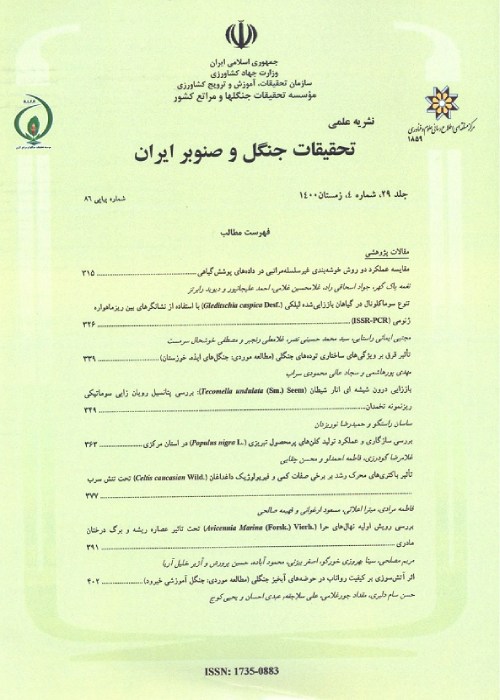Osmoprotectants and physiological responses of three Eucalyptus species to toxic concentrations of lead
Author(s):
Abstract:
One of the serious problems across the world is heavy metal pollution in water bodies that caused by Lead (Pb). This study was designed to find out the effect of Pb toxicity on physiological and biochemical changes in three Eucalyptus species (Eucalyptus camaldulensis Dehnh., E. microtheca F. Muell and E. occidentalis Endl.).Seeds were grown in marble chips and irrigated with nutrient solution. The seedling (42 days old) were exposed to Pb(NO3)2 treatments (Pb:50, 100, 200 mM) for ten months. After this period, leaf, stem and root tissues were harvested. Lead content were determined by ICP-OES and some physiological and morphological characters were determined. The order of Pb accumulation in three species were E. occidentalis> E. camaldulensis> E. microtheca. The concentrations of lead in root tissue were higher than leaf and stem tissue and stem concentration was lower than the concentration of leaf (root Cu>leaf Cu>stem Cu). Tissue concentration increased as Pb increased in three species. The content of prolin, soluble sugar raised by increasing metal concentrations, but the content of pigments, relative water content and specific leaf area decreased. These results suggest that eucalypts have efficient mechanism to tolerate Pb toxicity, as evidenced by accumulating of osmoprotectants. Comparison of three Eucalyptus species revealed that E. occidentalis had the highest concentrations of Pb in the leaves and stems. Accumulation of Pb in the E. occidentalis leaves was 2.38 and 1.82 times more than E. microtheca and E.camaldulensis respectively. Although the least amount of stress tolerance index (0.76) was observed in E. occidentalis. In general, the results showed that Eucalypts could be considered as a tolerant species for hyperaccumulation of lead and phytoremediation of contaminated soil by lead.
Keywords:
Language:
Persian
Published:
Iranian Journal of Forest and Poplar Research, Volume:25 Issue: 1, 2017
Pages:
137 to 148
magiran.com/p1697813
دانلود و مطالعه متن این مقاله با یکی از روشهای زیر امکان پذیر است:
اشتراک شخصی
با عضویت و پرداخت آنلاین حق اشتراک یکساله به مبلغ 1,390,000ريال میتوانید 70 عنوان مطلب دانلود کنید!
اشتراک سازمانی
به کتابخانه دانشگاه یا محل کار خود پیشنهاد کنید تا اشتراک سازمانی این پایگاه را برای دسترسی نامحدود همه کاربران به متن مطالب تهیه نمایند!
توجه!
- حق عضویت دریافتی صرف حمایت از نشریات عضو و نگهداری، تکمیل و توسعه مگیران میشود.
- پرداخت حق اشتراک و دانلود مقالات اجازه بازنشر آن در سایر رسانههای چاپی و دیجیتال را به کاربر نمیدهد.
In order to view content subscription is required
Personal subscription
Subscribe magiran.com for 70 € euros via PayPal and download 70 articles during a year.
Organization subscription
Please contact us to subscribe your university or library for unlimited access!



